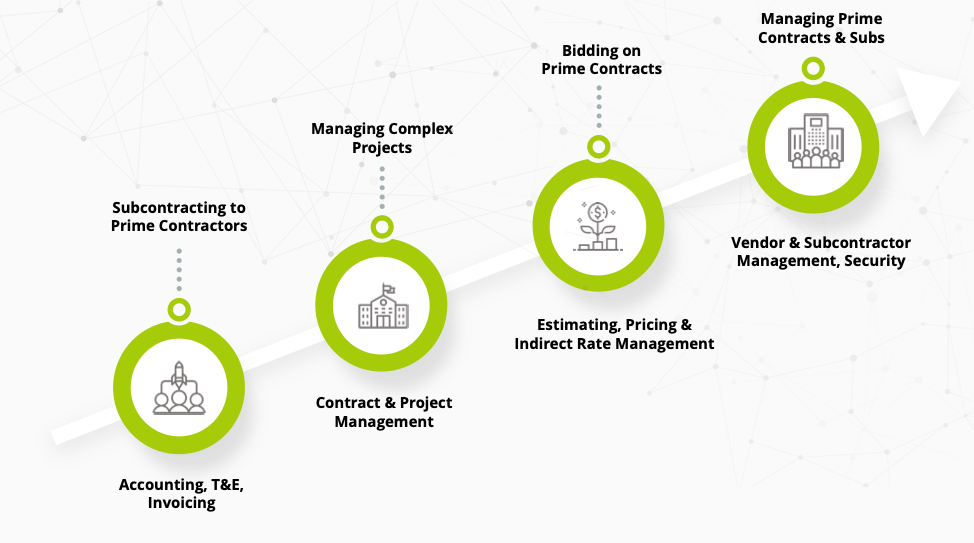
Graduating from 8(a) Program – (FAQ)
Understand the Small Business Administration 8(a) program and how to successfully graduate.
Each year the federal government sets aside contracts that will be awarded to firms in the 8(a) Program. The type of supplies and services the government buys using the contracts cover a wide range of items from providing administrative support to engineering services. 8(a) set asides allow the government to award contracts using limited competitions. Rather than competing with all firms in the market, 8(a) firms only compete with other firms in the program and can receive sole source awards. When bidding on full and open contracts, the federal government can provide incentives to 8(a) firms.
AtWork Outsourcing & Managed Services for GovCons
across functions like accounting, HR, finance, contract and project management.
While the 8(a) program can be a great way to get your firm started, relying on the 8(a) certification has its limitations. Sooner or later, 8(a) businesses "graduate" from the program because they no longer meet the qualification criteria. And even if they continue to meet the qualification criteria, they are only permitted to be in the program for nine years. Nine years and out.
Once out, the firm is out forever - and removed from its protective niche and must compete with the larger government contractors. And that could be where the real challenges begins.
A Senior SBA Official Stated
"Hundreds of small businesses enter the SBA's 8(a) business development program each year, but when those firms graduate, continued success and favor isn't a given. The playground is a lot flatter, their sole-source advantage is gone, and the competition is fierce."
The SBA's data shows that successfully graduating can be a challenge. Many 8(a) firms experience a significant downturn in their business after graduating and a majority fail. Overcoming these challenges requires a well thought out strategic plan.
We've compiled a list of questions that offers more detailed tips on how to successfully graduate from the 8(a) program that we recommend for you. In summary, staying focused on finding a market niche, building a corporate resume containing solid past performances, hiring strong talent, and managing business cash flow must be top priorites. It also requires developing client-facing and back-office capabilities while controlling your indirect cost so you can provide competitive pricing. The fundamental point is that firms who are in the 8(a) program need to have a plan for how to navigate graduation, because once they depart their protected safe harbor, things tend to get a lot harder and many companies do not survive the change in a competitive environment.
What is the 8(a) Program?
Government contracting can be a very lucrative business. The SBA 8(a) program is a robust nine-year program created to help firms owned and controlled by socially and economically disadvantaged individuals. If you are a member of one of these groups, the government's 8(a) program can be a great way to bootstrap your business as it provides both training and business development opportunities. Check out the SBA 8(a) Program website for details on program eligibility.
What percentage of firms successfully graduate?
The program is a great way to bootstrap firms that want to do business with the federal government. While the program has undeniable benefits, only 35% of companies successfully graduate from the 8(a) program.
How can a strategic plan improve success after graduating?
 Improving your chances of success after you graduate requires developing and executing a comprehensive strategic plan that allows you to compete in the full and open competitive environment. This means that you must be able to deliver competitive wrap rates such as a wrap rate of 1.65 which is where your most capable competitors perform. Investing in and developing the right client-facing and back-office capabilities is the foundation to establishing indirect rates required to compete and win in full and open competitions.
Improving your chances of success after you graduate requires developing and executing a comprehensive strategic plan that allows you to compete in the full and open competitive environment. This means that you must be able to deliver competitive wrap rates such as a wrap rate of 1.65 which is where your most capable competitors perform. Investing in and developing the right client-facing and back-office capabilities is the foundation to establishing indirect rates required to compete and win in full and open competitions.
Learn More: How to Successfully Graduate from the 8(a) Program - A Strategy for Success
What capabilities are needed as a subcontract or prime contractor?
Successful federal contractors need a range of corporate capabilities to implement a successful graduation strategy from the 8(a) program. Building your firm's capabilities in a way that you can stay lean and have competitive indirect rates starts when you enter the 8(a) program. Throughout the process of building capabilities stay focused on leveraging technology to eliminate manual processes. Building lean capabilities will drive competitive pricing.
Growing Your GovCon Capabilities

Most GovCon firms have a proposal win rate of 30% if you can increase your win rate to this level it will significantly increase your chances of successfully graduating. Bidding and winning are the key success factor to survival. You need to build a solid plan for growing the capabilities, described above.
Like all successful government contractors, 8(a) firms face three significant challenges when growing their business: (1) building the corporate capabilities needed to consistently deliver ... you'll need niche skills and solid past performance, (2) understanding what it takes to win new contracts in your market segment, and (3) controlling the growth of indirect cost. Graduating from the 8(a) Program will create a greater sense of urgency to address these challenges. Improving the ability to deliver and win requires thoughtful investment in the right "back-office" infrastructure (processes and systems) that underpin required capabilities. Developing and executing a strategy starts years before graduating.
Learn More: How to Successfully Graduate from the 8(a) Program - Building Capabilities for Success
Why are competitive indirect rates so important when bidding on full and open competition?
Let's assume you've done well in the 8(a) program; your firm has developed a great capability and it has great past performance. Before graduation, you should ask how you can improve your ability to win full and open competitions. The table below provides significant insight that should shape your strategy. The bottom line, you'll need to make some hard decisions focused on creating competitive indirect rates. In full and open competitions, you'll be competing with larger firms that will have much lower indirect rates.
| Indirect Rates By Annual Revenue | |||||
| Indirect Rate Type | Average | $0-<10M | $10-<25M | $25-<50M | $50M+ |
|---|---|---|---|---|---|
| Fringe Rate | 27% | 26% | 28% | 24% | 29% |
| Overhead Rate for Contractor Sites | 25% | 18% | 30% | 37% | 20% |
| Overhead Rate for Customer Sites | 17% | 13% | 21% | 21% | 16% |
| Material/Subcontractor Handling Rate | 4% | 5% | 3% | 3% | 3% |
| General and Administrative Rate | 19% | 21% | 22% | 20% | 11% |
| Wrap Rate Without Fee | 1.81 | 1.74 | 1.93 | 1.93 | 1.65 |
Contractors with more than $50 million in revenue enjoy distinct advantages regarding their indirect rates. If your indirect rates aren't comparable, winning full and open competitions will be difficult. This is a leading cause of why many organizations fail to graduate out of the 8(a) program.
Learn More: How to Successfully Graduate from the 8(a) Program - Importance of Competitive Indirect Rates
Learn More About AtWork Systems
AtWork Systems is an Arlington, Virginia based software development company. Its principals have decades of experience doing business with and working for federal, state, and local government. They developed OneLynk as a configurable and scalable business operating platform that digitizes and optimizes processes while providing just in time business intelligence for decision making. OneLynk contains a suite of easily configurable web applications for automating and monitoring business transactions, including: human capital management, finance, timekeeping and expense management, procurement, contracts and project management, payroll services and more. Check it out at www.AtWorkSys.com and see for yourself!
